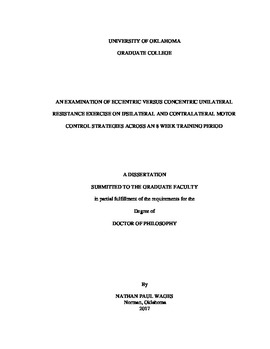| dc.description.abstract | Traditionally, contralateral training interventions have been applied in the unilateral limb to examine the potential short-term “cross-over” responses and long-term “cross education” adaptations in the contralateral limb. Despite the completion of a multitude of studies, there is still a nescience regarding differences in training adaptations based solely upon specificity of training phase (e.g., concentric [CON] vs. eccentric [ECC] exercise). PURPOSE: To compare the training adaptations elicited from CON vs. ECC resistance exercise to evaluate the ipsilateral and contralateral limb’s responses and adaptations. METHODS: Twenty healthy, college-aged (18-35 years old) men (N = 10) and women (N = 10) volunteered to participate in this investigation. Participants were required to unilaterally resistance train three days per week for a total of eight weeks. Participants were randomly assigned into either CON or ECC training groups and were asked to perform bicep curls for five sets of ten repetitions (to momentary fatigue) per training visit with their dominant limb only. Ipsilateral and contralateral limb responses and adaptations were evaluated in two week increments following the initial familiarization visit. Cross-sectional area (CSA), maximal dynamic strength, maximal isometric strength, and force fluctuations during submaximal contractions (30%, 50%, and 70% of maximal voluntary contraction [MVC]), as well as surface electromyographic (EMG) and mechanomyography (MMG) signals were collected during all evaluation visits. RESULTS: When ECC and CON unilateral exercises are performed in isolation, ECC training causes a greater stimulus for promoting neurophysiological adaptations (e.g., greater increase in CSA, maximal dynamic and isometric strength, and a decrease in force fluctuations [e.g., greater improvement in force steadiness]) across time. Furthermore, these neurophysiological adaptations are not only greater in the trained (ipsilateral) limb, but it also appears that they are greater in the untrained (contralateral) limb through inter-limb transfer of sensorimotor adaptations. CONCLUSIONS: Our results further support the findings from previous research which indicated that ECC unilateral training was a better stimulator for contralateral responses and adaptations when compared to CON unilateral training. Therefore, we have concluded that our results were attributed to an increase in neural drive and a decrease in corticospinal inhibition, which would cause greater cross-over responses and cross-educational adaptations due to a larger percentage of neural impulses remaining on the ipsilateral side of the body and not crossing over (at the medulla oblongata) to the contralateral side. | en_US |
